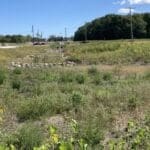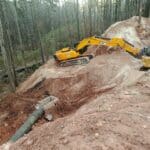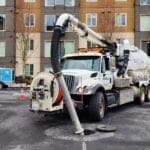City of Ann Arbor
Excerpt from Stormwater Ordinance
Stormwater Rates
The stormwater rate system bills properties based on usage of the storm water system, as represented by impervious area. Impervious surfaces do not absorb water. Examples of impervious areas include roofs, pavement, sidewalks, patios, and gravel or crushed stone surfaces.
How is stormwater usage measured by impervious area?
A computer analysis of infrared aerial photographs is able to distinguish hard, impervious surfaces in contrast to areas that can absorb stormwater, such as lawns and gardens. The computer program assigns the residential property into one of four billing tiers to more equitably distribute costs proportional to use instead of using a flat fee. Homes with larger impervious areas pay more. You can review your property’s stormwater assessment online and, if desired, submit an appeal (see below).
Stormwater Credits
You can take advantage of credits to lower your storm water bill.
Requirements
Under the Post Construction Stormwater Management control measure, the City of Ann Arbor has a program requiring new and redevelopment projects to implement on-site controls that will reduce pollutant loads in stormwater run-off. The City of Ann Arbor follows the rules of the Washtenaw County Water Resources Commissioner for post construction controls. These rules are incorporated by reference into Chapter 63 of the City Code – Stormwater Management and Erosion and Sedimentation Control.
City staff review site plans for compliance with regulations governing stormwater management.
Chapter 63 (5:658) requires all site plans to include a plan for the long-term maintenance of stormwater controls:
“A program proposal for the continued maintenance of all permanent soil erosion and sedimentation control measures that remain after project completion, including the designation of the person or party responsible for the maintenance. Maintenance responsibilities shall become a part of any sales or exchange agreement for the land on which the permanent soil erosion and sedimentation control measures are located.”
Utilizing Low Impact Development (LID)
Low impact development (LID) is the industry standard for green infrastructure. The LID Manual for Michigan provides the latest tools for implementing post construction stormwater controls.
What is LID? In short, it is a type of development that uses a basic principle modeled after nature – to manage rainfall using design techniques that infiltrate, filter, store, evaporate, and detain runoff close to its source. LID provides a host of stormwater benefits, including groundwater recharge and cleaner streams.
Keep the following in mind if you are implementing a LID project:
- Plan for stormwater management during initial phases of site design
- Manage stormwater close to where it falls
- Conserve and restore natural areas
- Minimize impervious surface
- Manage runoff with structural controls
- Provide maintenance and education
- Examples of LID Practices for Stormwater
Implementing LID practices can:
- Reduce the volume of stormwater flows
- Improve the quality of stormwater runoff
- Reduce the need for future capital improvements to maintain or repair stormwater systems
Infiltration
- Practices designed to facilitate the percolation of runoff through the soil to groundwater
- Result in reduced stormwater runoff quantity and reduced mobilization of pollutants
- Examples: infiltration basins/trenches, dry wells, permeable pavement (shown)
Stormwater Retention/Detention
- Control stormwater by gathering runoff in wet ponds, dry basins, or multi-chamber catch basins and slowly releasing it to receiving waters or drainage systems
- Can be designed to both control stormwater volume and settle out particulates for pollutant removal
Vegetative
- Landscaping features that, with optimal design and good soil conditions, remove pollutants and facilitate percolation of runoff
- Maintain natural site hydrology, promote healthier habitats, and increase aesthetic appeal
- Examples: grassy swales, filter strips, artificial wetlands, and rain gardens
Links:
Ann Arbor Stormwater Ordinance
Ann Arbor Unified Development Code
SE Michigan Stormwater Homepage
Water Infrastructure Homepage
Best Management Practices for Stormwater A Developer’s Guide for Ann Arbor (PDF)
Community Partners for Clean Streams
 Kenosha, Wis. Highway KR Regenerative Stormwater ConveyanceThe Root-Pike Watershed Initiative Network Kenosha County, and others worked with AQUALIS to design and implement an innovative solution for stormwater control along Highway KR.
Kenosha, Wis. Highway KR Regenerative Stormwater ConveyanceThe Root-Pike Watershed Initiative Network Kenosha County, and others worked with AQUALIS to design and implement an innovative solution for stormwater control along Highway KR. Durham, N.C. Sinkhole Leads to Stormwater System RehabilitationThe tenant on this property noticed a depression that opened to the ground below and notified the property owners.
Durham, N.C. Sinkhole Leads to Stormwater System RehabilitationThe tenant on this property noticed a depression that opened to the ground below and notified the property owners.
